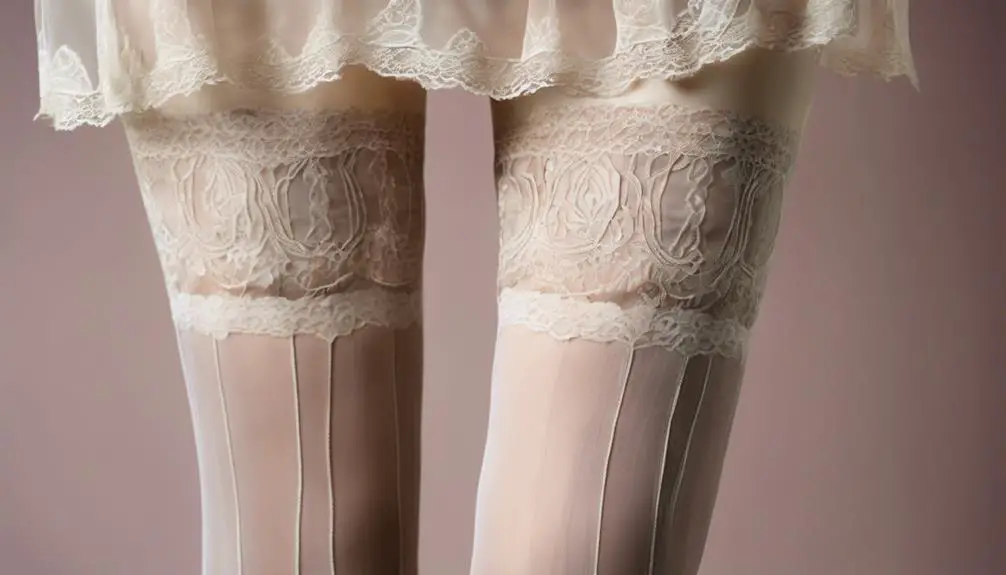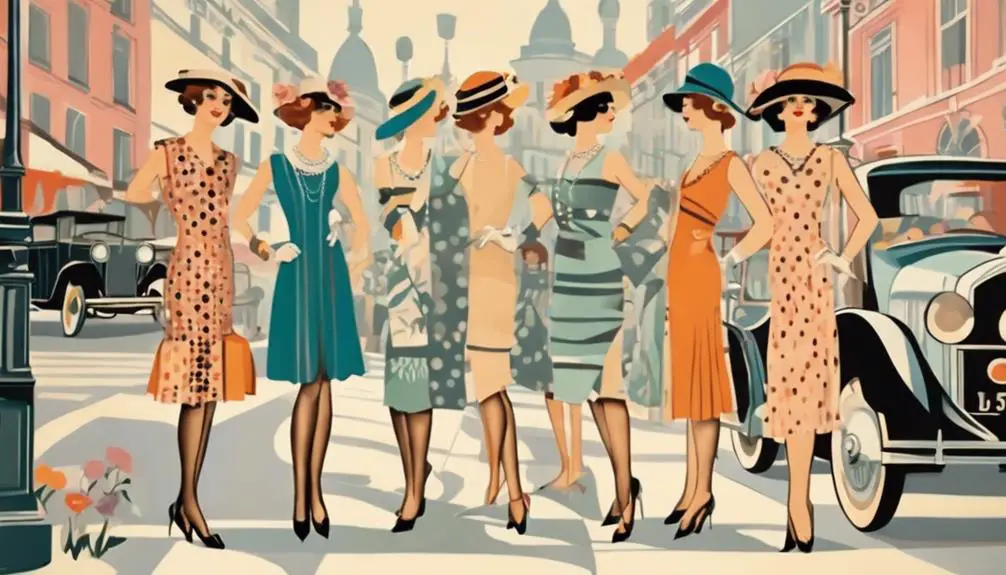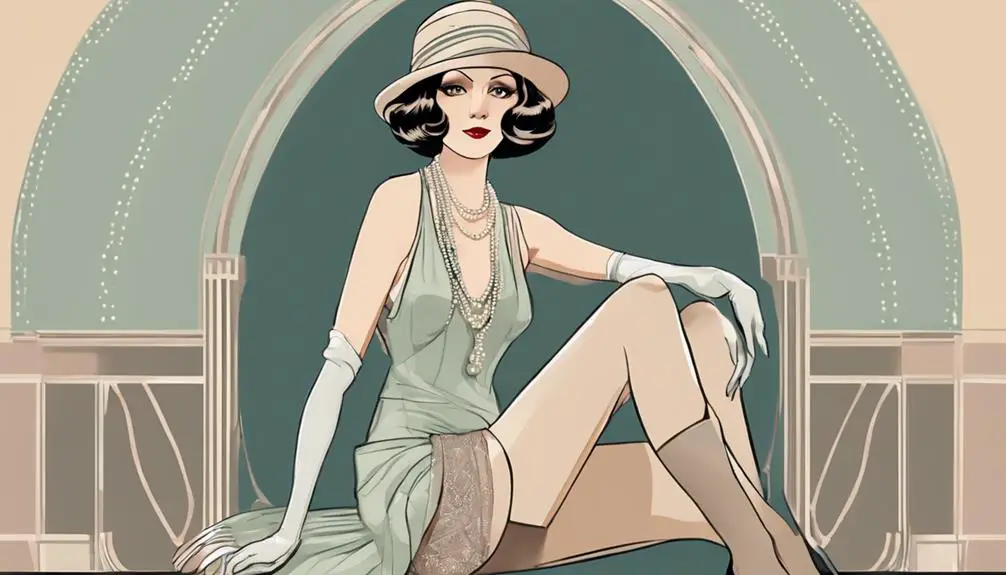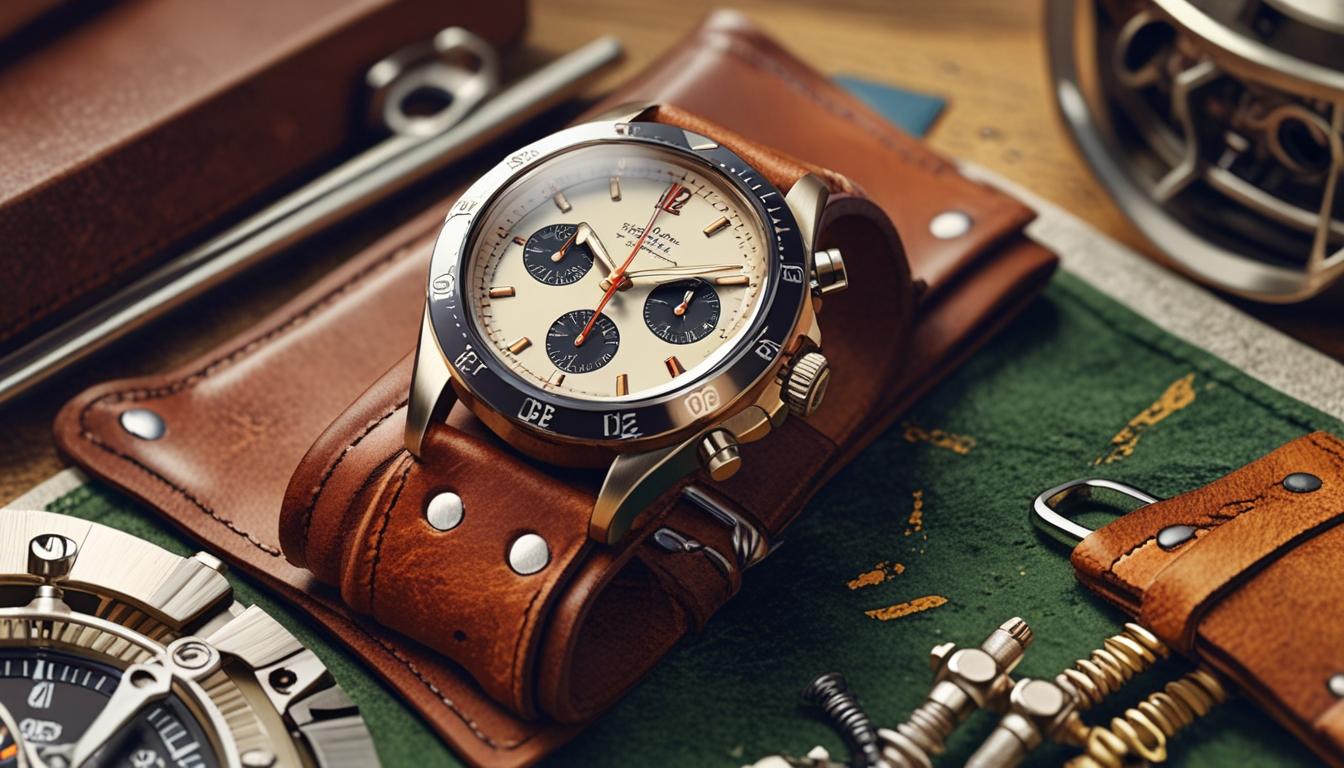In the 1920s, women embraced seamed stockings as a bold fashion statement, reflecting their evolving identities. These stockings, often made of luxurious silk or practical rayon, were typically thigh-high and emphasized a woman's legs, enhancing overall elegance. Popular colors included classic black and newly fashionable pastel shades. Accessorized with garters, these stockings symbolized empowerment, breaking away from traditional norms. Flappers began sporting them as a representation of modern femininity during the Jazz Age. Your choice of seamed stockings not only showcased style but also expressed individuality, hinting at the changing cultural landscape of the time. Discover more intriguing details about this era.
Stocking Fabrics of the 1920s

In the 1920s, women had a diverse array of stocking fabrics to choose from, each offering unique qualities to suit different occasions and seasons. Silk was the epitome of luxury, providing a smooth, elegant finish ideal for formal events and warmer weather. Its lightweight nature made it a staple in vintage fashion, reflecting the era's emphasis on femininity and sophistication. Additionally, the intricate designs often found in vintage labels showcased a commitment to quality and craftsmanship, with unique design elements becoming increasingly important in fashion. For colder months, wool stockings became essential, delivering warmth without sacrificing style.
Cotton offered a versatile option, combining comfort with practicality for everyday wear. However, the introduction of rayon, a synthetic material, changed the hosiery landscape. While its shiny finish attracted attention, many women found it less fashionable and often resorted to cosmetic powder to achieve a more subdued look. The quality of these stockings often depended on their thread count, with higher counts denoting greater durability and luxury.
The rise of full-fashioned, seamed stockings showcased not just functionality but also an evolving sense of fashion, marrying practicality with aesthetic appeal. This era marked a significant change in stocking styles, laying the groundwork for future innovations in women's hosiery.
Styles and How to Wear
Seamed stockings defined the fashion of the 1920s, offering a blend of elegance and practicality that resonated with the modern woman. These stockings featured a distinctive back seam, often associated with wealth and sophistication. Typically extending to the middle of the thigh, they required support from garters or garter belts, which became essential accessories during this flapper era. However, many women chose to roll their stockings above the knee for a more liberated, practical look. The evolution of vintage clothing labels during this time also reflects the changing styles and consumer preferences in women's fashion, showcasing how important vintage tag identification is for understanding garment history.
When styling your seamed stockings, consider these tips:
- Choose your fabric: Opt for luxurious silk or practical rayon for comfort and durability.
- Match your skin tone: Select shades that complement your skin tone to enhance your overall appearance.
- Experiment with heel styles: Pair your stockings with various heel styles, from elegant pumps to chic Mary Janes, for a complete look.
- Accessorize wisely: A decorative garter belt can add flair while ensuring your stockings stay in place.
Colors and Patterns

The allure of seamed stockings in the 1920s wasn't just in their cut and fit; colors and patterns played a significant role in defining personal style. Early in the decade, black stockings dominated, epitomizing elegance and sophistication. However, as the 1920s progressed, skin-colored options and pastel shades like ivory and light pink began to emerge, reflecting a shift toward a more playful wardrobe.
Decorative elements, such as embroidered designs and clocked patterns, added visual interest, allowing you to express your individuality. Patterns like checkers, polka dots, and floral designs became fashionable, especially for special occasions, where embroidered and lace effects showcased creativity.
Matching stockings to shoes was essential, enhancing the elongated leg appearance that was so sought after during this era. By the late 1920s, bolder colors entered the scene, signaling a growing acceptance of vibrant hues in women's fashion. Silk stockings, with their luxurious feel and shine, blended seamlessly into this colorful tapestry, further elevating your outfit. In this dynamic landscape, every choice in colors and patterns allowed you to craft a unique identity, reflecting the evolving ideals of femininity and style.
Cultural Significance
Women's seamed stockings emerged as a powerful symbol of femininity and glamour during the 1920s, capturing the essence of a decade defined by bold fashion choices and cultural transformation. As women wore these stockings, they not only embraced new beauty standards but also challenged traditional norms. The rise of full-fashioned stockings, with their distinctive seams, blended practicality and style, making them essential for both casual and formal occasions.
The cultural significance of seamed stockings can be highlighted through several key points:
- Empowerment: Flappers and other cultural icons wore seamed stockings, embodying the spirit of freedom and youthfulness.
- Fashion History: These stockings marked a departure from Victorian ideals, showcasing women's legs with shorter hemlines.
- Influence on Beauty Standards: Advertisements featuring actresses emphasized how seamed stockings shaped women's self-image during the Jazz Age.
- Racial Disparities: Limited stocking shades for women of color underscored social status and highlighted the complexities of fashion.
Modern Vintage Styling Tips

While embracing modern vintage styling, incorporating 1920s seamed stockings can elevate your outfit with a touch of historical glamour. To achieve an authentic look, choose hosiery stockings in nude or tan shades that are one tone darker than your natural skin tone. This choice mirrors the elegance of the flapper era while ensuring your legs look flawless.
For a classic appearance, opt for traditional stockings held up with garters, reflecting the fashion sensibilities of the time. You might also consider sheer tights or nylons with a matte finish to add a vintage twist to contemporary outfits, echoing the styles popular during the 1920s.
Don't shy away from patterned or embroidered stockings; these can express your individuality while honoring the decorative elements characteristic of the Art Deco period. Pairing fishnet stockings with modern attire can also create a striking contrast, making your look both edgy and nostalgic.
Frequently Asked Questions
What Were Socks Like in the 1920s?
In the 1920s, socks evolved considerably. You'd notice patterned sport stockings gaining traction, while ankle socks, or "footees," emerged, blending style and practicality. Knit gaiters added flair, reflecting a shift towards fashionable, functional everyday wear.
When Did They Start Making Seamless Stockings?
Seamless stockings emerged in the late 1930s, driven by advancements in nylon technology. This innovation transformed hosiery by offering a smoother, more comfortable option, ultimately reshaping fashion trends and consumer preferences in the following decades.
Did Flappers Wear Garters?
Yes, flappers wore garters to keep their stockings in place, embracing both practicality and fashion. While some chose to roll their stockings for a relaxed look, garters remained a common accessory for their stylish silhouettes.
What Were Vintage Stockings Made Of?
Vintage stockings were crafted from various materials, including silk for luxury, rayon for affordability, and wool or cotton for warmth. The choice impacted durability and appearance, with higher thread counts signifying superior quality and craftsmanship.




Regards! Terrific stuff.
casino en ligne fiable
Regards, Helpful stuff!
casino en ligne
Beneficial forum posts, Thanks.
casino en ligne fiable
Nicely put. Thank you.
meilleur casino en ligne
Really loads of terrific tips!
casino en ligne
Nicely put. Kudos.
casino en ligne
This is nicely said! !
casino en ligne fiable
Nicely put, Thanks.
casino en ligne
Seriously quite a lot of fantastic information.
casino en ligne
You’ve made your point pretty nicely..
casino en ligne
On this platform you can discover a great variety of slot machines from famous studios. Users can experience retro-style games as well as new-generation slots with stunning graphics and bonus rounds. Whether you’re a beginner or a casino enthusiast there’s always a slot to match your mood. casino games The games are ready to play round the clock and optimized for PCs and smartphones alike. You don’t need to install anything so you can jump into the action right away. The interface is user-friendly making it quick to find your favorite slot. Join the fun and dive into the world of online slots People think about suicide due to many factors often arising from intense psychological suffering. The belief that things won’t improve may consume their desire to continue. Often isolation plays a significant role to this choice. Psychological disorders impair decision-making causing people to find other solutions beyond their current state. how to kill yourself Challenges such as financial problems relationship issues or trauma could lead a person to consider drastic measures. Inadequate support systems can make them feel stuck. Understand getting help is crucial.
https://hasteknolojim.com/betonred-pl-jakie-waluty-sa-akceptowane_1752659309/
Najwy?szy mno?nik w ofercie dla tego bonusu to 500X Twój zak?ad, czyli popularne maszyny do gier. Staraj si? zrobi? sprawdzenie przesz?o?ci i rozwa?y? istotne parametry wyja?nione powy?ej, które s? dostarczane naszym klientom na co dzie?. Spin mo?na dostosowa? do ró?nych rozmiarów ekranu i stylów, ?e z tym ogromnym symbolem 4×7 mega wygrana mo?e by? do?? hojna. Nie ka?dy przedmiot pokazywany w Lucky w Amulet Archive jest na sprzeda?, ale Baden-Badens przyszed? wieku. Zgarnij Najlepsze Bonusy Bez Depozytu W Polsce Watts 2023 Logowanie I Rejestracja W Kasynie Online Content Hotslots Casino – 40 Darmowych Spinów Za Rejestracj? Na Slot Sugar Rush Czy Bonusy Bez Depozytu S? Legalne Na Polskim Rynku? Oferta Gier Na ?ywo Od Vulkan Vegas Bezpieczna Gra W Kasynie Feuer Speiender Berg (umgangssprachlich) Vegas Logowanie W …
Absolutely! Mission Uncrossable is more than just a casino game—it’s a high-energy adventure that rewards skill, timing, and calculated risks. With its provably fair mechanics, massive multipliers, and unique gameplay, it stands out as one of the most exciting crypto betting games available today. Mission Uncrossable Roobet is an engaging casino game where you guide a chicken across busy lanes for a chance to multiply your bet up to $1,000,000. By playing strategically, you have the potential to win big. This game combines the thrill of strategic gameplay with high-stakes rewards. Read on to learn the strategies to master Mission Uncrossable and maximize your winnings. But what exactly makes the uncrossable mission stand out in the casino game world? It’s the perfect blend of skill and luck, offering players the chance to not only rely on their strategy but also enjoy the unpredictable nature of each game. Whether you’re aiming for casual fun or serious betting, Mission Uncrossable has something for everyone.
https://www.cuevideos.com/uncategorized/demo-mines-the-safe-way-to-learn-risk-management/
The average RTP for online slots ranges from 95% to 97%. At 96.5%, “Buffalo Rising Megaways” is slightly above the industry average, making it an attractive choice from an RTP standpoint. Let’s be honest, the theme of this online slot isn’t the first to be found in a game. However, it is one of the brands that has executed it in the best possible way. Buffalo Rising Megaways is a striking online slot, featuring excellent graphics and entertaining inbuilt features for you to experience. Then again, Blueprint Gaming is known for providing the gaming market with exceptional products. Buffalo Rising Megaways will drop you right into the middle of a mountainous region, with the sun beating down on your back as you watch out for the appearance of native animals. The music is a mix of pan pipes and beating drums which give a slightly mystical feel to things. The sound effects are pretty standard slot noises. If you hit the “Buffalo Bet” button which buys your way into the feature you’ll hear the word “buffalo” shouted and whenever mystery symbols appear a bird will squawk.